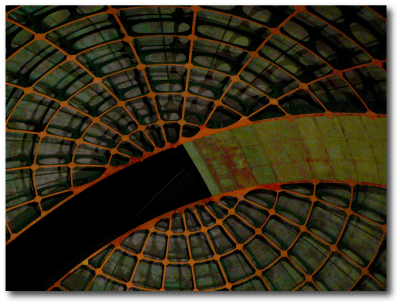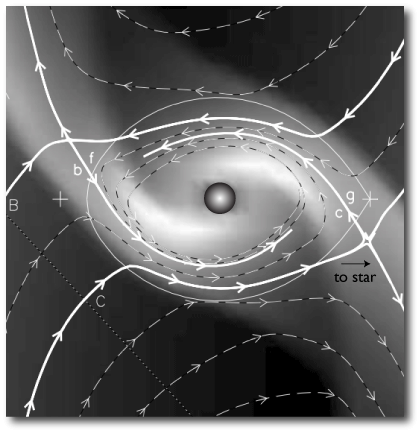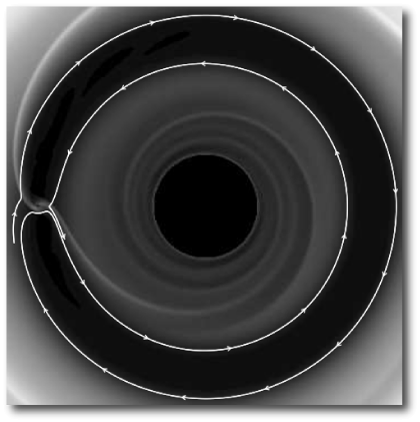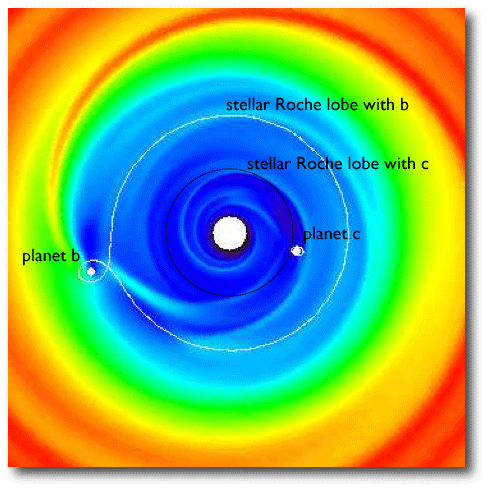
Image Source.
Galileo’s discovery of the four major Jovian satellites — his Medicean Stars — revealed that Jupiter is accompanied by a planetary system in miniature. In his Dialogue on the Two Chief World Systems, Galileo drew on the obvious analogy between Jupiter and its moons on the one hand and the Sun and the planets on the other as evidence in favor of the Copernican worldview.
The pattern is that when an orbit is larger, the revolution is completed in a longer period of time; and when smaller, in a shorter period. Thus Saturn, which traces a greater circle than any other planet, completes it in thirty years; Mars in two; the moon goes through its much smaller orbit in just a month; and in regard to the Medicean stars, we see no less sensibly that the one nearest Jupiter completes its revolution in a very short time (namely about forty-two hours), the next one in three and one-half days, the third one in seven days, and the most remote one in sixteen. This very harmonious pattern is not changed in the least as long as the motion of twenty four hours is attributed to the terrestrial globe (rotating on itself).

Image Source.
Two decades ago, prior to the discovery of the extrasolar planets, the Galilean satellites, along with the regular satellite systems of Saturn and Uranus, constituted one of the strongest hints that extrasolar planets should exist. In each case, the total fractional mass and relative orbital scale of the satellites is quite similar, implying that a robust and generic formation process was at work. There’s a factor-of-twenty difference between the masses of Jupiter and Uranus, but the fractional mass caught up in their satellites differs by only a factor of two. The Jovian satellites add up to 0.021% of Jupiter’s mass, whereas the Uranian moons amount to 0.011% of Uranus’ mass. Similarly, the Saturnian satellite system (which is completely dominated by Titan) has a total mass amounting to 0.025% of Saturn. In all three cases, the orbital distance of the outermost large satellite is between 20 and 60 planetary radii.
Robin Canup and Bill Ward of Boulder’s Southwest Research Institute have developed a compelling formation model that naturally accounts for the similarities between the giant planet satellite systems (see here and here). In their picture, regular satellites build up from solid particles that flow into the circumplanetary disks from the surrounding solar nebula. Once a nascent moon reaches a non-trivial size, it decouples from the inward spiral of gas, and is able to rapidly accrete large quantities of solid particles. Ultimately, a satellite’s ability to grow to very large size is shuttered by Type I migration, whose timescale decreases in inverse proportion to the satellite mass. In the Canup-Ward picture, a succession of Jovian satellites form and are accreted onto the central planet when their mass exceeds ~0.02% of the planetary mass.
The flow pattern in the outer region of a protoplanet’s Roche lobe that regulates the flow of gas into the circumplanetary disk is quite complicated. Here’s an image adapted from the hydrodynamical simulations of Steve Lubow and his collaborators (paper here) that shows the streamlines in the vicinity of the forming planet’s Roche lobe:

The gravity of the Sun produces a tidal barrier which meters the flow of gas into the protoplanetary disk, and Canup and Ward compare the Jovian satellites to the buildup of mineral deposits on the interior of a pipe through which a great deal of water has flowed.
Squeezing out regular oklo posts is a bit of a challenge. I want to keep the posting schedule fairly regular in order to keep the readership up, but at the same time, its sometimes hard to keep coming up with post-worthy topics. In trolling for ideas, I often go to the Extrasolar Planets Encyclopaedia and comb through the tables, looking for patterns or analogies. A bit more than a year ago, I noticed that Gl 876 d, with its 1.92-day orbit and its 0.007% mass ratio is reminiscent of a Jovian satellite. Could it have arisen from a direct analog of the Canup-Ward formation process?
In the Gl 876 system, the middle planet c would have metered the gas flow into Gl 876’s inner circumstellar disk. A considerable amount of the inward flowing gas in the nascent Gl 876 system would have accreted onto planet c, but there was likely a stream (or streams, given the additional presence of planet b) that bypassed the planets and flowed onto the inner disk. The low density of steadily flowing gas in the inner disk would have allowed planet d to feed on the incoming solid material while staving off demise via Type I migration. The formation of d through this process would have occurred entirely within the Gl 876 snowline, and so in this picture, planet d is composed largely of iron and silicates. Figure 10 from the Lubow et al. paper gives a nice sense of how gas and small solid particles would have slipped by planet c on their way in:

Willy Kley and his collaborators have done hydrodynamical simulations which model the interaction between that the outer two Gl 876 planets and the parent gas disk. The flow pattern in the vicinity of the planets is more complicated than in the single-planet case, and streams of gas (and small particles) are able to flow into the disk region interior to the 30-day orbit of planet c. It’s not unreasonable to imagine that the combined presence of planets b and c mediated an inner circumstellar disk around GJ 876 that was reminiscent of the circumplanetary disk around a Jovian planet. Here’s an example figure from the Kley et al. paper showing the hydrodynamical flow in the vicinity of planets b and c:

It thus seems plausible that GJ 876 d could indeed owe its origin to the same process that produced the Jovian satellites. The planet d that shows up in the radial velocity data might be the largest survivor among a number of similar iron-silicate planets that formed in the gas-starved inner disk and were then lost to the star via type I migration. In keeping with the analogy to Jovian satellites, this scenario would hint at additional, somewhat smaller iron-silicate planets circling Gl 876 in orbits with periods in the 4-12 day range. Looks like more RVs are in order!
A manufacturing scheme akin to the giant planet satellite formation process is, however, not the only way to produce Gl 876 d. Doug Lin and his collaborators, for example, have suggested that GJ 876 d formed from pre-existing icy planetesimals that were herded inward during the resonant migration of the massive outer planets b and c. In their picture, Gl 876 d is made largely from water, and would thus have a larger physical radius than if it was built primarily from silicates via a Jovian satellite-like formation process. Mandell et al. outline a related mechanism by which d could have formed via resonant shepherding.
It’s a shame that d doesn’t transit.
Are there any other inner planets that might be candidates for formation via the Canup-Ward mechanism? Plausible clues would consist of a short orbital period, a ~0.01% mass ratio, and a massive outer planet in a ~10-50 day orbit. 55 Cancri e just might fit that bill…

The Gliese 876 system is a weird one for sure… especially given that the other M-dwarf jovians are in much longer-period orbits.
Of course 55 Cancri is another interesting one. Now consider this: the Extrasolar Planets Encyclopaedia gives an orbital solution with the jovian planets in high eccentricity orbits; the Catalog of Nearby Exoplanets lists a solution with near-circular orbits; Jack Wisdom claims that planet “e” doesn’t exist but there is a Neptune-mass planet in the gap between planets “c” and “d”; and on the backend systemic users have contributed a total of 142 fits between the two datasets. Surely some kind of analysis is possible on that!
Hi Greg,
GJ 876 has been of tremendous interest to me for many months. I have done many fits for this system, each with rather low Chi² values. But, in every case the RMS remained more or less the same. I wrote to Eugenio about it asking if any more RV data would be collected sometime in the near future, to which he replied that they working on trying to get that done sometime this year. So, I’m in total agreement with you that more RVs are in order. There’s presently enough data to establish periodicities, but not enough to establish any other parameters.
I’m very intrigued by the Canup-Ward Jovian satellites analogue as well as the Doug Lin et al and the Mandell et al resonant shepherding idea.
best,
Eric
Hi Greg:
Excuse me to put a monkey wrench in your thoughts.
None of those analyzes consider that the Jovian system was formed under the influence of the Sun, influence that does not exist in GJ 876 or any of the exoplanets.
Mike
Here’s a great article from this week’s East Bay Express about the California and Carnegie Planet Search. This is an excellent piece, well written and full of great details about the process of extracting meter-per-second precision from 100-year-old starlight. There are also some interesting details about the history of modern planet searching.
More velocities are on the way. But just remember, each little data point represents a long, hard night spent a long way from home…
Thanks, John for the link.
Eric
Pingback: Interesting extrasolar planet discoveries - Page 3 - Bad Astronomy and Universe Today Forum
Pingback: systemic - in situ?